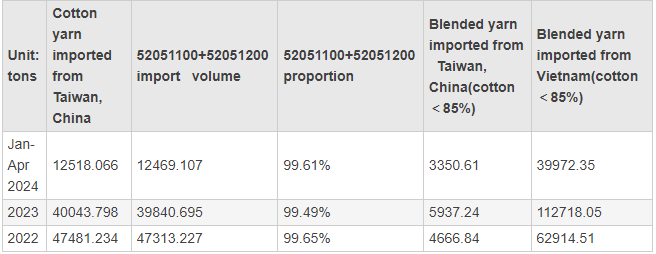Taiwan’s cotton yarn mills challenged by suspension of tariff concession
According to the Ministry of Finance of People's Republic of China, due to the long-term discriminatory trade restrictions imposed unilaterally by the Taiwan provincial authorities on the mainland China, which violate the provisions of the Economic Cooperation Framework Agreement (ECFA) regarding "reducing and eliminating substantial tariffs and barriers in bilateral trade in goods". The Tariff Commission of China's State Council issued a notice on May 30th. Starting from June 15, 2024, the preferential tariff rates under the ECFA for 134 import goods originating from Taiwan, China, will be suspended.
Starting from January 1, 2024, the agreement tariff rates applicable to 12 imported products including propylene, Paraxylene, etc. originating from Taiwan will be suspended, and the current relevant regulations will be implemented. The list of tariff concession suspensions this time includes more categories such as chemicals, metal products, textiles, and electromechanical parts. Among them, 16 types of textile products, including cotton yarn, synthetic fibers, fabrics, and knitted fabrics, are listed. The export value of the products involved in this round accounts for more than half of the total exports from Taiwan province, making the impact significant. If they lose the tariff preferences, the competitiveness of these products in exports to the mainland China will be significantly weakened.
Currently, the cotton yarn trade industry is mostly affected by two categories: 52051100(Uncombed single cotton yarn, cotton≥85%, yarn≥714.29decitex)and 52051200(Uncombed single cotton yarn, cotton≥85%, 232.56≤yarn<714.29decitex). Corresponding to the market circulation specifications, they mainly include uncombed single yarn below 8s and uncombed single yarn of 8-25s, which are the mainstream specifications of cotton yarn factories in Taiwan, China.

According to the operating reports of the following manufacturers, Taiwan's open-end yarn mills mainly serve the mainland market, with exports accounting for as much as 60-70% in recent years. Therefore, their biggest competition undoubtedly comes from mainland and Xinjiang local yarn mills, as well as some yarn mills in Pakistan (0% cotton yarn import tariff), India (3.5% cotton yarn import tariff), Vietnam (0% cotton yarn import tariff), Malaysia (0% cotton yarn import tariff), and other regions that also export to China. Previously, with the advantage of import tariff reductions and geographical location, Taiwan, China's imported yarn had a competitive edge over cotton yarn from other Asian production areas in terms of price, delivery time, shipping costs, and duration, maintaining a stable sales share year after year. After the suspension of tariff concessions on June 15th, taking example of open-end yarn 10s contamination controlled with an export price of $1.88/kg, if the import tariff is restored to 5%, the customs clearance cost from Taiwan, China for open-end yarn will be forced to increase by about 400yuan/mt. With the thin profits in yarn imports, this will significantly reduce the attractiveness to mainland traders, possibly leading to a situation where profit turns into losses. It will create a significant price competitiveness gap compared to open-end yarn from Vietnam, Malaysia, and Indonesia, which primarily use US cotton as the main raw material and enjoy zero tariffs.

According to customs data, in recent years, imported yarn from Taiwan Province has mainly been cotton yarn, with categories 52051100 and 52051200 accounting for over 99% of the total imports, making them the dominant categories. The suspension of tariff concessions has undoubtedly targeted the key sector of cotton yarn exports from Taiwan Province. Currently, blended yarns (cotton<85%) are not included in the list, but the export volume of blended yarns is relatively small compared to cotton yarn, indicating that Taiwanese yarn mills may shift towards self-rescue and transformation by gradually increasing the production and export of blended and synthetic yarns and gradually shifting sales markets to Southeast Asia. However, Vietnam remains the largest source of blended (CVC, TC) yarn imported into the Chinese market, with a share that is more than ten or even twenty times that of blended yarn imported from Taiwan Province.
- Top keywords
- Cotton Price
- Cotton Futures Price
- Cotton Futures
- CZCE
- PTA Futures Price
- Chemical Fiber
- Polyester Prices
- Wool price
- PTA Futures
- Shengze Silk
- China
- Yarn Price
- price
- China Textile City
- Fibre Price
- Benzene Price
- Cotton
- Index
- Cotton Index
- PTA
- fabric price
- NYMEX
- Top 10
- textile industry
- Spot Cotton
- Cotton Yarn
- Polyester Price
- Futures
- PTA Price
- cotton yarn price

